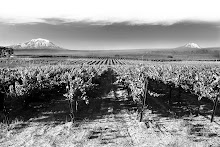Mornin' on the Desert
Mornin' on the desert, and the wind is
blowin' free,
And it's ours, jest for the breathin', so let's fill up, you and me.
No more stuffy cities, where you have to pay to breathe,
Where the helpless human creatures move and throng and strive and seethe.
Mornin' on the desert, and the air is like a wine,
And it seems like all creation has been made for me and mine.
No house to stop my vision, save a neighbor's miles away,
And a little 'dobe shanty that belongs to me and May.
Lonesome? Not a minute: Why I've got these mountains here,
That was put here just to please me, with their blush and frown and cheer.
They're waiting when the summer sun gets too sizzlin' hot,
An' we jest go campin' in 'em with a pan and coffee pot.
Mornin' on the desert-- I can smell the sagebrush smoke.
I hate to see it burnin', but the land must sure be broke.
Ain't it jest a pity that wherever man may live,
He tears up so much that's beautiful that the good God has to give?
"Sagebrush ain't so pretty?" Well, all eyes don't see the same,
Have you ever seen the moonlight turn it to a silvery flame?
An' that greasewood thicket yonder -- well, it smells jest awful sweet,
When the night wind has been shakin' it -- for its smell is hard to beat.
Lonesome? Well, I guess not! I've been lonesome in a town.
But I sure do love the desert with its stretches wide and brown.
All day through the sagebrush here the wind is blowin' free.
An' it's ours jest for the breathin', so let's fill up, you and me.
And it's ours, jest for the breathin', so let's fill up, you and me.
No more stuffy cities, where you have to pay to breathe,
Where the helpless human creatures move and throng and strive and seethe.
Mornin' on the desert, and the air is like a wine,
And it seems like all creation has been made for me and mine.
No house to stop my vision, save a neighbor's miles away,
And a little 'dobe shanty that belongs to me and May.
Lonesome? Not a minute: Why I've got these mountains here,
That was put here just to please me, with their blush and frown and cheer.
They're waiting when the summer sun gets too sizzlin' hot,
An' we jest go campin' in 'em with a pan and coffee pot.
Mornin' on the desert-- I can smell the sagebrush smoke.
I hate to see it burnin', but the land must sure be broke.
Ain't it jest a pity that wherever man may live,
He tears up so much that's beautiful that the good God has to give?
"Sagebrush ain't so pretty?" Well, all eyes don't see the same,
Have you ever seen the moonlight turn it to a silvery flame?
An' that greasewood thicket yonder -- well, it smells jest awful sweet,
When the night wind has been shakin' it -- for its smell is hard to beat.
Lonesome? Well, I guess not! I've been lonesome in a town.
But I sure do love the desert with its stretches wide and brown.
All day through the sagebrush here the wind is blowin' free.
An' it's ours jest for the breathin', so let's fill up, you and me.
The author of "Mornin' in the
Desert" is unknown, though the poem is sometimes attributed to John R. Nielson. This poem was published in a single-author collection of
poetry published in Arizona in 1910, called "Songs from the Sage Brush" by
Katherine Fall Pettey. The poem was also featured in an episode of the old radio show called
"Death Valley Days" as well as used in many periodicals, newspapers,
books throughout the 20th century, and recently has had an upsurge in
popularity on webpages on the internet.











